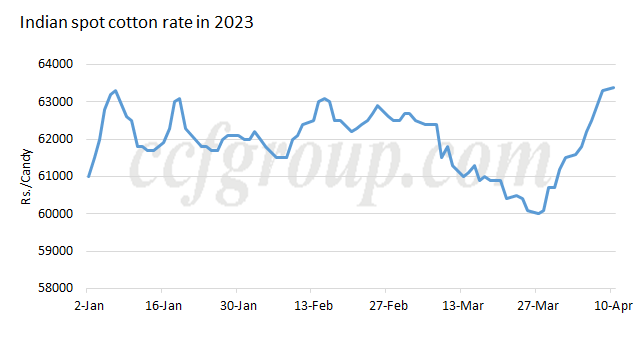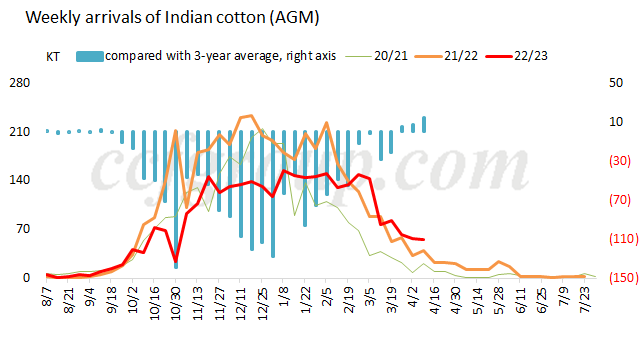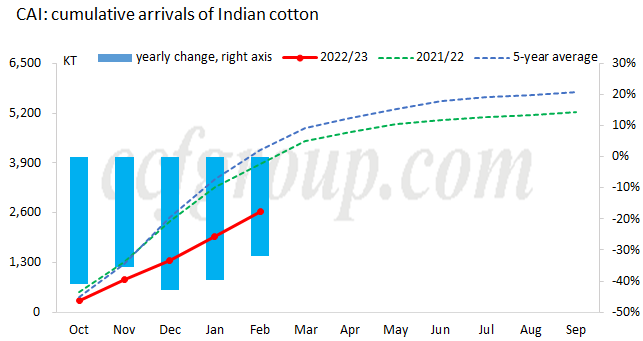In recent one month, panic mood was triggered by the banking system problems and plus the slow recovery of textile and apparel consumption, the international cotton prices have ticked down overall. Though the fears cool down currently, the consumption is still in slow recovery, while only Indian cotton prices are firm, showing an uptrend. By Apr 8, the Indian spot cotton rate has risen to Rs. 63,300 per Candy, equivalent to about 98.58cent/lb, and the local S-6 cotton average offers increase to Rs. 62,150 per Candy, reaching the highest since Mar 9, as well as the prices of J-34 price. The reasons are analyzed below.

1. Continual low arrivals of Indian cotton
According to Ministry of Agricultural, arrivals of Indian cotton have been decreasing, and the weekly arrivals are only about 55kt last week, basically drawing to a close. By Apr 9, 2023, cumulative arrivals of Indian cotton were 3.068 million tons, far lower than previous years, and there was large gap with the CAI’s production forecast of 5.32 million tons. Under such circumstance, local cotton prices gain strong support. Moreover, according to Cotton Association of India, the arrivals by end Feb were 2.632 million tons, a fall of 32% year on year, which was also not optimistic. Based on current arrivals, 2022/23 Indian cotton production is supposed to be hard to reach 5 million tons, and there are concerns over the large supply gap.
2. Growing demand for cotton from downstream market
According to foreign media, buyers in the downstream industry were active in the first week of the new fiscal year 2023-24, cotton yarn transactions in South India picked up, and cotton yarn prices in the Mumbai market rose by 2-3 pounds per kilogram. Market players claimed that this wave of market conditions was mainly because that the local spinning mills’ operating rate has reached a relatively high level, but the cotton inventory in spinning mills was lower than that of the same period in previous years. At the same time, the orders from Chinese market and from Turkey and Europe due to the impact of the previous earthquake have made the consumption of cotton increase. Indian cotton consumption has shown a rising trend in recent months.
Moreover, the government continues to release policy to support downstream capacity expansion, putting certain confidence to textile industry. At present, the plan of seven giant comprehensive textile zones and garment parks is advancing. The Indian government has also introduced policies to reduce import tariffs on certain textile machinery, spare parts and accessories, including shuttleless looms in the category of zero tariffs. These policies are expected to alleviate the current problems of low value-added, high production costs and low profits in India's downstream textile industry, and promote the healthy operation of the downstream textile industry.


3. Good performance of PMI in Mar
India's Manufacturing Purchasing Managers Index in Mar rose by 1.1 percentage points from the previous month to 56.4, indicating that India's manufacturing industry has relatively strong resilience after the epidemic. The textile industry is the main constituent system of India's manufacturing industry. Against the background of the sluggish performance of global commodities during the U.S. interest rate hike cycle, India's PMI can still be higher than 50. The signal of economic expansion has brought positive sentiment to India's local textile industry.
In general, in the case of low supply and high demand expectations, Indian cotton prices show an upward trend. If the subsequent reduction in Indian cotton arrivals leads to the intensification of domestic cotton supply and demand contradictions and an out-of-control market like last year, it cannot be ruled out the government may remove the cotton import duty, which can support global cotton prices up.
Πηγή: ccfgroup.com

